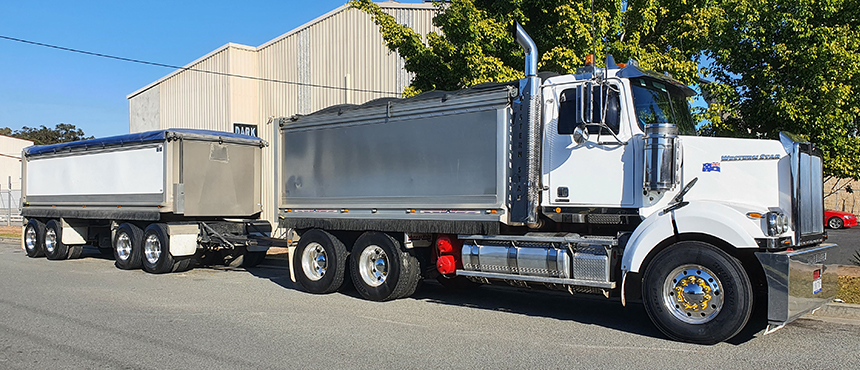A look at the Advantia PBS Toolbox – Tier 1 Mass Calculator
Advantia offers a range of online services for the heavy vehicle industry to assist with PBS vehicle design and assessment. In this article, we take a closer look at how to use the Tier 1 Mass Calculator.
Advantia offers four services as part the PBS Toolbox on our website. All you need to do to get started is go to the toolbox, enter your email address, and select a tool from the left. The four tools currently available on the website are listed below.
- Tier 1 Mass Calculator
- Low-speed check
- Low-speed assessment
- Swept path overlay.
In this article, we’ll be taking a look at the first one, the Tier 1 Mass Calculator.
Tier 1 Mass Calculator
The first of the free tools, the Tier 1 Mass Calculator, makes it easy to calculate your Tier 1 mass limits. You can read more about Tier 1 mass limits here if you’re curious. Let’s take a look at how you might calculate the Tier 1 mass limit for the truck and dog shown below.

Dimensions highlighted blue are relevant to steps further down in this article.
After entering your email and selecting the Tier 1 Mass Calculator on the website you’ll be presented with the first three questions;
- The target PBS Level for the vehicle,
- number of axle groups in the vehicle, and
- whether the vehicle qualifies for 6.5 tonnes on the truck steer axle.

PBS Level: A 3-axle truck and 4-axle dog can potentially operate at PBS Level 1 or 2. We’ll target PBS Level 2, since we’ll usually want to operate above the normal Level 1 limit of 50.5 tonnes. PBS Level 2 will allow this truck and dog to go up to 57.5 tonnes.
Number of axle groups: For any normal truck and dog, we’ll have four axle groups, two on the truck and two on the dog.
6.5 steer? (Otherwise limited to 6t): We’ll assume that the truck in this design qualifies for 6.5 tonnes on the steer axle; almost any modern truck will.
Once that’s done, click on ‘Start’ to bring you to the next stage of the calculator.

A 3-axle truck and 4-axle dog, courtesy of Smart Heavy Vehicle Certifications.
This next part is easy, just enter the number of axles in each group, as shown below. Click on ‘Axle length’ to proceed to the final stage of the calculator.

Finally, you need to enter in the distance between each axle. Conveniently, our layout drawing shows these dimensions already, so it’s just a matter of entering the dimensions as they’re shown.

After clicking ‘Calculate’, you’ll be shown the results, just like what we’ve got below.

The maximum mass that we could have achieved with this combination going by standard axle group limits and ignoring Tier 1 mass limits is 1.2 tonnes higher than our Tier 1 result.
Not bad, but there’s certainly room for improvement here. Making the vehicle longer will usually improve the Tier 1 mass result. Let’s say we decided to increase our drawbar length by 500 mm from 4,954 mm to 5,454 mm.
Fortunately, we don’t need to go through the entire process again to make a minor change. All we need to do is;
- Recalculate our axle spacings and edit them as required.
- In our case, increasing our drawbar length by 500 mm increases our ‘3 – 4’ axle spacing by the same amount.
- Click on ‘Calculate’ for the new results.

That’s closer, but not quite at the maximum axle loads that we’re targeting. Let’s increase it by another 300 mm and recalculate the result.

That final change allowed us to reach our maximum axle loads. With our optimised results in hand, we can save them by clicking on the last button to email them to the address that we entered at the start of the process.
In this example, we only looked at what the Tier 1 mass would be for Level 2.
If you want to check what your mass would be for Level 1, it’s just like adjusting the axle distance dimension.
- Scroll back up to the top, change the PBS Level selection to Level 1 and click on ‘Start’.
- All values and dimensions that have already been entered will be stored.
- Go back down to the bottom of the page and click ‘Calculate’ to see the results for Tier 1 mass for Level 1.
Keep an eye out for the next blog article when we explore how to use the Low-Speed Check tool.
Contact Advantia if you would like to investigate PBS opportunities for your business.
Get more like this in your inbox
Subscribe to our Newsletter and never miss a post.